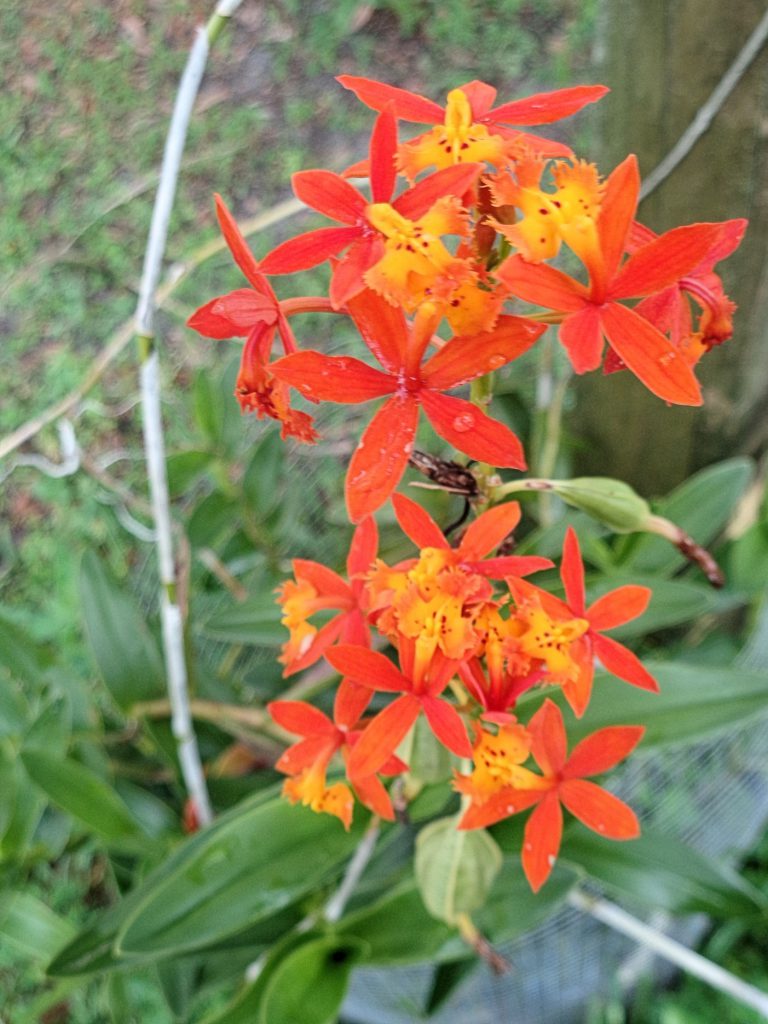
Have you read about the reed orchid? This orchid may be more common than you think. A very affordable type of ground or terrestrial orchid, this little beauty is sometimes seen at garden centers, at plant sales, and even as a random plant in your neighbor’s yard. Easy to propagate with stunning tropical flowers, the reed orchid or Epidendrum has a place in your yard.
The reed orchid highlighted today is botanically known as Epidendrum radicans. Originally from Central America and Mexico, the reed orchid grows about two and one-half to three-feet tall with multiple green stems and many white roots that prop and support each other as the plant colony grows. Mature plants produce clusters of up to forty individual, long-lasting orange and yellow flowers per stem that look like tiny, slender cattleyas. Morning sun with some afternoon shade provides the ideal amount of light to produce flowers on and off all-year round.
Propagation is as easy as division. I picked up my reed orchid at a Master Gardener Plant Sale as a mere sprig. In time, it had grown out of its pot and required larger accommodations. I reset my reed orchid into a chicken-wire mess tube filled with bark and organic materials and supported with a wooden upright. Over time, the orchid rooted into this glorified pot. The most interesting reed orchid set-up I ever saw was a chicken wire mesh, multiple-tiered tower filled with bark that was magnificently covered with these tightly-knit reed orchids – it was a nice display!
Reed orchids need well-drained soil mixes. Fir bark and perlite mixtures work well as a potting mix for containers, while in-ground reed orchids do fine in just plain sandy potting soil. Use reed orchids as informal accent plantings near entries, as a border around a porch, or along a walkway. They really lend themselves as a naturalized mass planting or tall groundcover. Place individual plants about two and one-half feet apart and they will eventually fill in the spaces.
While the most common reed orchid flower color is orange and yellow, there are a number of hybrids which sport dark red, pure orange, yellow, and even reddish-purple colors. Reed orchids are tropical plants, so they may need protective coverings during frosty winter cold snaps. Too much cold weather may make the foliage a bit bronze in color as well. Any damage tends to grow back in time.
The reed orchid will offer a sparkle of color and interest in your landscape – this orchid is easy! For more information on all types of ornamental herbaceous plants suitable for our area, or to ask a question, please visit https://www.facebook.com/CharlotteMGLifeline/. Ralph E. Mitchell is the Director/Horticulture Agent for the UF/IFAS Charlotte County Extension Service. He can be reached at 941-764-4344 or ralph.mitchell@charlot tecountyfl.gov.
Resources:
Rose, J. & L. Cal-Orchid, Santa Barbara, California – www.calorchid.com
Landre, C. (2020) Spathoglottis plicata & Epidendrum radicans. South-Florida-Plant-Guide.com
Warner, K. (2017) Reed-stemmed Orchid – Epidendrum radicans https://blogs.ifas.ufl.edu/nassauco/2017/06/09/fact-sheet-reed-stemmed-orchid/
 3
3
